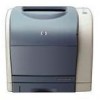HP 2500 HP PCL/PJL reference - Printer Job Language Technical Reference Manual - Page 213
Example Printing System, Printer Status Readback and Printer Sharing
 |
View all HP 2500 manuals
Add to My Manuals
Save this manual to your list of manuals |
Page 213 highlights
Example Printing System Figure 11-1 contains an example printing system. The print system contains one I/O-switching LaserJet printer which is connected to seven computers. Host computer #1 is connected via the serial I/O interface. Host computers #2 and #3 are connected through an external printer sharing box that also buffers print job data. The printer sharing box is connected to the printer through the IEEE-1284compatible I/O interface. Network servers #4 and #5 spool print jobs from network clients #6 and #7. Although all the network clients and spoolers are connected to the same network cable as the printer, only the two network servers are capable of communicating directly with the printer. In this example, the network clients spool print jobs to a network server; they can not interact directly with the printer. Given the printing system as shown in Figure 11-1, not all of the printing system components can query the printer and expect a response back. Printer Status Readback and Printer Sharing Host computer #1 is directly connected to the printer via the bi-directional serial I/O link. If the software on the host computer supports bi-directional printer communication, applications on host computer #1 can expect the printer to respond to queries. However, at the time an application on host computer #1 requests information, the printer may be processing a print job from a different I/O interface, so the response to host computer #1's query may be delayed, as described in the "Printer Status Readback and Printer I/O Switching" section in this chapter. Host computers #2 and #3 are connected to the printer via an external printer sharing box that buffers data. If the printer sharing box was not designed to support bi-directional communication with the printer, then applications on host computers #2 and #3 will not be able to receive printer status readback information. However, since the printer sharing box is connected to the printer via the Bi-Tronics I/O interface, which does support bi-directional communication, it is possible for printer sharing boxes to be designed to support printer status readback. In fact, the printer sharing box itself may be able to inject a "print job" to query the printer for specific information. External printer sharing boxes can be designed to support sending data from the printer to the host computer. However, the printer sharing box has to determine which host computer should receive the EN Programming Tips for Using PJL 11-19















